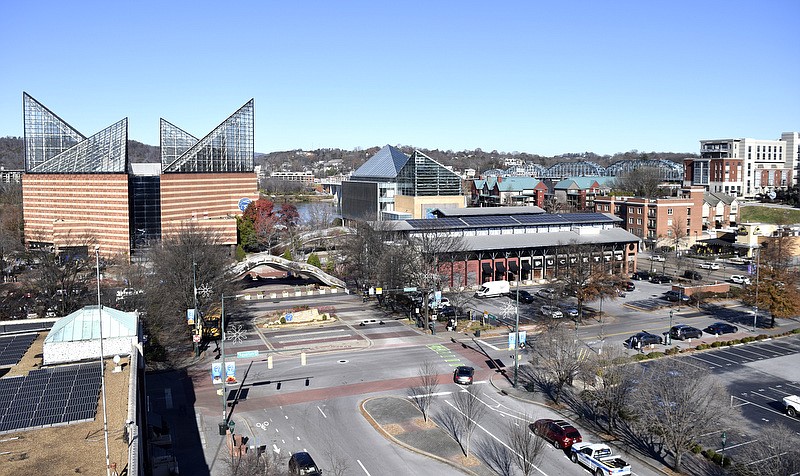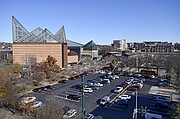Seeking a road map to re-energize Chattanooga's downtown riverfront area and spur more activity, River City Co. is overseeing a new planning effort to chart the district's future.
The current home of the Chattanooga Lookouts at AT&T Field is expected to be a key part of the plan, with River City calling the minor league baseball park "potentially the most impactful site in the study by sheer size."
The future of Riverfront Parkway, the Tennessee Aquarium's connection to the river, and ways to make Fourth, Broad and Market streets more people and business friendly, also will undergo study.
In addition, the development of parking lots around the aquarium, the Creative Discovery Museum and others in the district will be examined, according to officials.
The planning process, called One Riverfront Chattanooga, will look at the district bordered by the Tennessee River, Fourth Street, Cameron Hill and the Bluff View Arts District. A plan is slated to be ready by July 4, officials said.
Kim White, River City's chief executive, said one of the key issues to address is the loss of energy at the riverfront. She said, for example, that parking revenues are down 20% in the waterfront district.
Keith Sanford, who heads the Tennessee Aquarium, said the district "has lost some of its shine" to other parts of the downtown area, citing vacant restaurants as an example.
"I think this can help revitalize that," said Sanford, who's on the plan's steering committee.
White said that some people now call the area "the tourist district." The Southside, meanwhile, has thrived in recent years with trendy restaurants and lots of new apartments drawing local citizens.
Still, the waterfront remains the front door to the city, White said.
More Info
To learn more, visit www.oneriverfrontcha.com.
"How do we inject more energy into the riverfront area?" she asked.
Amy Donahue, River City's director of marketing, said the study won't be so much about future development as creating activity, animation and programming in the district and making it first and foremost for Chattanoogans.
"We want people to think about space they can enjoy every day," she said. "It needs to be special 365 days of the year."
Columbus, Ohio-based urban design and planning firm MKSK has been hired to lead the study, financed by River City, the nonprofit downtown redevelopment group, and the Lyndhurst and Benwood foundations. The plan's cost wasn't revealed.
Darren Meyer, principal at MKSK, said the firm does a lot of work with cities returning to their riverfronts. But, he said, what's unusual in this instance is that Chattanooga was a pioneer in doing so, and now it wants to take another look with fresh eyes.
Regarding AT&T Field, Meyer said that nothing is static and there are "always big moves happening."
"We'll take the best information we have in hand now and look at scenarios that will make the district successful in the future," he said.
The South Broad District Plan last year identified the Wheland/U.S. Pipe foundry sites as a potential home for a multi-use entertainment venue that could include a new minor league baseball stadium.
At the same time, a few weeks ago, reports surfaced that Major League Baseball is proposing that its minor leagues be reduced from 160 teams to 120, beginning with the 2021 season, and Chattanooga is one of the franchises at risk.
Meyer said the plan will look at creating a framework for the district to succeed that allows for a number of potential land uses, developments or anchors.
Also, as the planning process eyes Riverfront Parkway and the other major arteries in the district, Meyer said that it won't examine any street in isolation.
"We look at what's happening around it." he said. "We look at the whole package and make recommendations on a comprehensive approach."
One Riverfront Chattanooga's primary focus is on helping build a district "that's for people and particularly Chattanoogans," Meyer said.
"If you make it walkable, livable, comfortable ... that's the rising tide that raises all ships," he said.
Barry White, who heads the Chattanooga Convention and Visitors Bureau and is also on the steering panel, said the plan will primarily focus on local residents.
"Visitors will come to enjoy our lifestyle and our culture," he said. "That's what they're looking for. It's an opportunity to create, imagine, design it and build it for the future."
Donahue said the process will have a lot of community engagement, connecting with even those who live in neighborhoods outside of downtown and may not come to the riverfront.
"We're very intentional that we want a process that's multi-faceted," she said.
MKSK officials plan to be in Chattanooga next week, going on a walking tour of the district and meeting with the plan's steering committee, Donahue said.
In late January, plans are for the first community meeting, which will start the larger engagement with the public. A website for more information is up at www.oneriverfrontcha.com, and there are five questions people can answer to provide some early feedback, Donahue said.
Contact Mike Pare at mpare@timesfreepress.com or 423-757-6318. Follow him on Twitter @MikePareTFP.

